All 7 results
Sort by
Best selling Food and Culture notes
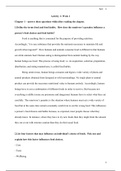
-
Activity 1
- Case • 4 pages • 2020 Popular
- Available in package deal
-
- CA$4.97
- 2x sold
- + learn more
1.Define the terms food and food habits. How does the omnivore’s paradox influence a person’s food choices and food habits? Food is anything that is consumed for the purpose of providing nutrition. Accordingly, “it is any substance that provides the nutrients necessary to maintain life and growth when ingested”1. How humans and animals consume food is different in that humans eat while animals feed. Human eating is distinguished from animal feeding by the way human beings use food. Thi...
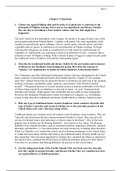
-
Activity 12
- Case • 4 pages • 2020 Popular
- Available in package deal
-
- CA$6.39
- 1x sold
- + learn more
1. Choose one typical Filipino dish and describe it. Explain how it conforms to the principles of Filipino cooking. Select one or two ingredients and discuss whether they are due to an influence from another culture and why that might have happened. The dish I chose for this description is the Lumpia. Its similar to an egg roll and is one of the most popular traditional Filipino dishes – together with pancit. The main ingredients of the Lumpia are ground pork, green cabbages, carrots, onions,...
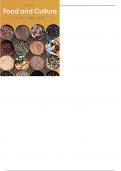
-
Food and Culture 6th Edition by Pamela Goyan Kittler - Test Bank
- Exam (elaborations) • 122 pages • 2023 Popular
-
- CA$45.26
- + learn more
Test Bank For Food and Culture 6th Edition by Pamela Goyan Kittler Test Bank1 for Food and Culture 6e Chapter 3: Intercultural Communication Multiple Choice Questions 1. What characteristics represent the “tip of the iceberg” in the iceberg analogy used to describe communication? a. Religion, educational background, political affiliation b. Ethnicity (or nationality), age, gender c. Degree of assimilation, age, ethnicity (or nationality) d. Religion, gender, age 2. In the “ice...
Do you also write study notes yourself? Put them up for sale and earn every time your document is purchased.
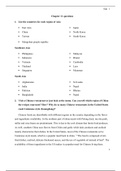
-
Activity 11
- Case • 4 pages • 2020 Popular
- Available in package deal
-
- CA$5.68
- + learn more
1. Visit a Chinese restaurant or just look at the menu. Can you tell which region of China the recipes represent? How? Why do so many Chinese restaurants in the United States cook Cantonese style (Guangdong)? Chinese foods are identifiable with different regions in the country depending on the flavor and ingredients availability. In the northern part of china meals with Peking duck, mu shu pork, millet and soya beans are predominant. This is due to the cool climate that limits food produces. As...
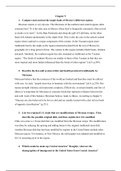
-
Activity 9
- Case • 3 pages • 2020 Popular
- Available in package deal
-
- CA$10.66
- + learn more
1. Compare and contrast the staple foods of Mexico’s different regions. Mexican cuisine is very diverse. The Mexicans of the northern and central regions often consume beef. “It is the only area in Mexico where beef is frequently consumed, often served as steaks or in stews”. In the Baja Peninsula and along the gulf of California, on the other hand, fish features prominently in the staple food.
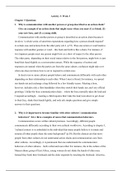
-
Activity 3
- Case • 4 pages • 2020 Popular
- Available in package deal
-
- CA$4.97
- + learn more
1. Why is communication with another person or group described as an action chain? Give an example of an action chain that might occur when you meet (1) a friend, (2) your new boss, and (3) a young child. Communication with another person or group is described as an action chain because it involves “a whole series of unwritten expectations regarding how a person should respond” to certain cues and actions from the other party (ch.3, p.57)........
Newest Food and Culture summaries

-
Food and Culture 6th Edition by Pamela Goyan Kittler - Test Bank
- Exam (elaborations) • 122 pages • 2023 New
-
- CA$45.26
- + learn more
Test Bank For Food and Culture 6th Edition by Pamela Goyan Kittler Test Bank1 for Food and Culture 6e Chapter 3: Intercultural Communication Multiple Choice Questions 1. What characteristics represent the “tip of the iceberg” in the iceberg analogy used to describe communication? a. Religion, educational background, political affiliation b. Ethnicity (or nationality), age, gender c. Degree of assimilation, age, ethnicity (or nationality) d. Religion, gender, age 2. In the “ice...

-
Activity 1
- Case • 4 pages • 2020 New
- Available in package deal
-
- CA$4.97
- 2x sold
- + learn more
1.Define the terms food and food habits. How does the omnivore’s paradox influence a person’s food choices and food habits? Food is anything that is consumed for the purpose of providing nutrition. Accordingly, “it is any substance that provides the nutrients necessary to maintain life and growth when ingested”1. How humans and animals consume food is different in that humans eat while animals feed. Human eating is distinguished from animal feeding by the way human beings use food. Thi...

-
Activity 12
- Case • 4 pages • 2020 New
- Available in package deal
-
- CA$6.39
- 1x sold
- + learn more
1. Choose one typical Filipino dish and describe it. Explain how it conforms to the principles of Filipino cooking. Select one or two ingredients and discuss whether they are due to an influence from another culture and why that might have happened. The dish I chose for this description is the Lumpia. Its similar to an egg roll and is one of the most popular traditional Filipino dishes – together with pancit. The main ingredients of the Lumpia are ground pork, green cabbages, carrots, onions,...
Do you also write study notes yourself? Put them up for sale and earn every time your document is purchased.

-
Activity 11
- Case • 4 pages • 2020 New
- Available in package deal
-
- CA$5.68
- + learn more
1. Visit a Chinese restaurant or just look at the menu. Can you tell which region of China the recipes represent? How? Why do so many Chinese restaurants in the United States cook Cantonese style (Guangdong)? Chinese foods are identifiable with different regions in the country depending on the flavor and ingredients availability. In the northern part of china meals with Peking duck, mu shu pork, millet and soya beans are predominant. This is due to the cool climate that limits food produces. As...

-
Activity 3
- Case • 4 pages • 2020 New
- Available in package deal
-
- CA$4.97
- + learn more
1. Why is communication with another person or group described as an action chain? Give an example of an action chain that might occur when you meet (1) a friend, (2) your new boss, and (3) a young child. Communication with another person or group is described as an action chain because it involves “a whole series of unwritten expectations regarding how a person should respond” to certain cues and actions from the other party (ch.3, p.57)........

-
Activity 9
- Case • 3 pages • 2020 New
- Available in package deal
-
- CA$10.66
- + learn more
1. Compare and contrast the staple foods of Mexico’s different regions. Mexican cuisine is very diverse. The Mexicans of the northern and central regions often consume beef. “It is the only area in Mexico where beef is frequently consumed, often served as steaks or in stews”. In the Baja Peninsula and along the gulf of California, on the other hand, fish features prominently in the staple food.

$6.50 for your textbook summary multiplied by 100 fellow students... Do the math: that's a lot of money! Don't be a thief of your own wallet and start uploading yours now. Discover all about earning on Stuvia
